Physics
NYA Mechanics
Examination
Part I: Problems
Solve all seven problems. Show all of your work, clearly and in order,
to receive full marks. If you use a formula not given on the formula sheet,
a derivation must be shown.
Problem 1
A car slows down from an initial velocity of 90.0 km/h to a final
velocity of 36:0 km/h at a constant rate while undergoing a displacement
of 105 m.
(a) What is the acceleration of the car?
(b) If the car continues with the same acceleration, how much additional
time will it take to come to a stop?
(c) What is the total displacement of the car from the instant when it's
travelling at 90km/h until it stops?
(d) Sketch the position-time curve for the car on the empty graph on
the next page. Indicate the time and position at which it stops
Answers:
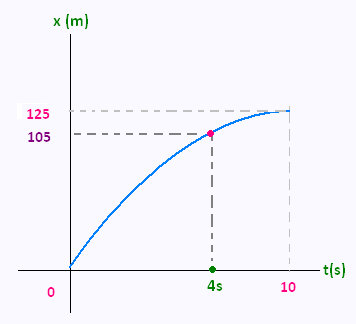
(a) Let's apply:
v2 - vo2 = 2 a ( x - xo)
a = (v2 - vo2)/2 (x - xo)
v0 = 90km/h = 90 x 1000/3600 = 25 m/s
v = 36 km/h = 36 x 1000/3600 = 10 m/s
a = (102 - 252)/2 x 150 = -2.50 m/s2
a = - 2.50 m/s2
(b) Let's apply:
v = at + vo
t = (v - vo)/a = (0 - 10)/(- 2.5) = 4 s
t = 4 s
(c) Let's apply:
x = xo + vo t + (1/2) a t2
x = 105 + 10 t + (1/2) (- 2.25) t2
x = 105 + 10 t - (2.25/2) t2
At t = 4 s , x = 105 + 10 (4) - (2.5/2) 42 = 125 m
x = 125 m
(d) See the figure.
Problem 2
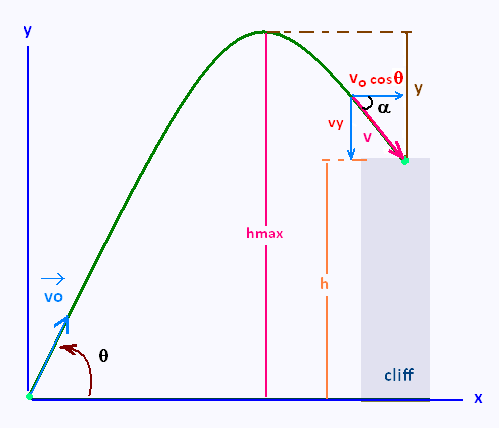
A projectile is launched at an angle of 53.1o above the horizontal
at a speed of 48:0m/s. The projectile lands on a 50.0 m high ledge.
(a) What is the horizontal distance from the launch point to the landing point ?
(b) What are the magnitude and direction of the projectile's velocity when it lands ?
(c) What is the maximum height reached by the projectile ?
Answers:
(a)
y = yo + vo t sin θ - (1/2) g t2
With yo = 0 , we have:
y = vo t sin θ - (1/2) g t2
50 = vo t sin θ - (1/2) g t2
Δ = vo2 sin2 θ - 100 g =
482 sin2 53.1 - 100 g = 493.40
t2 = (vo sin θ + √Δ)/g = 6.18 s
t2 = 6.18 s
We have
x = t2 vo cos θ
x = t2 vo cos θ 6.18 x 48 x cos 53.1 = 178.20 m
x = 178.20 m
(b)
v2 = vx2 + vy2
vy = vo sin θ - g t2
vy 2 = vo2 sin2 θ - 100 g
Then
v2 = vo2 - 100 g
v = √(vo2 - 100 g)
v = √(482 - 100 x 9.8) = 36.4 m/s
v = 36.4 m/s
α = cos-1 (vo cos θ/v) =
= cos-1 (48 cos 53.1/36.4) = 37.65o
α = 37.65o
(c)
2 g hmax = vo2 sin2 θ - 0
hmax = vo2 sin2 θ/2 g
hmax = 482 sin2 53.1 /2 x 9.8 = 75.2 m
hmax = 75.2 m
Problem 3
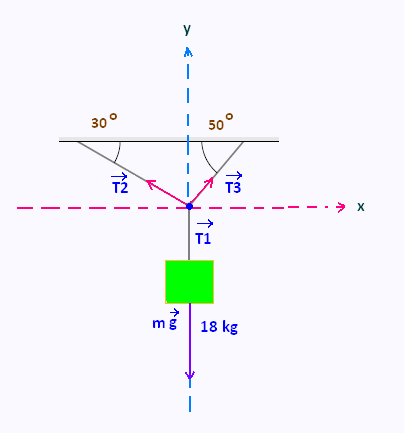
An 18.0 kg block is suspended from three cables as shown below.
What are the tensions T1, T2, and T3?
Answers:
Along x: T2 cos 50 = T3 sin 30
T2 = T3 sin 30 /cos 50
Along y : T1 = T2 cos 40 + T3 cos 60
T1 = mg
T1 = 18 x 9.8 = 176.40 N
T1 = 176.40 N
T2 = mg/(cos 40 + cos 50/cos30)
T2 = 115 N
T3 = mg/(1 + cos 40 x cos 30 /cos 50)
T3 = 155 N
Problem 4
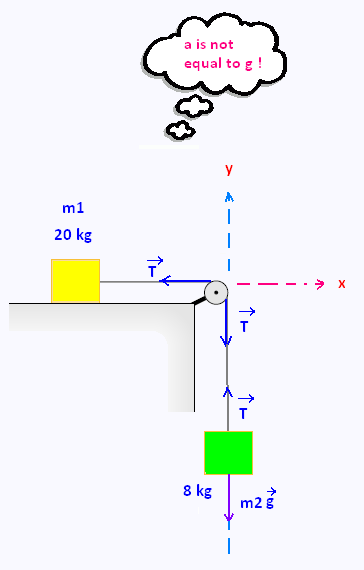
A 20.0 kg block on a horizontal surface is connected to a hanging 8.00 kg
block by a string, as shown below.
(a) What is the minimum coefficient of static friction between the 20.0 kg block and the
surface that would prevent the masses from moving ?
(b) If the surface is frictionless, what is the acceleration of the 20.0 kg block
and the tension in the string ?
Answers:
(a)
μs 20 x g ≥ 8 x g
μs 20 ≥ 8/20 = 2/5 = 0.40
Minimum μs = 0.40
(b)
Along x : T = m1 a
Along y : m2 g - T = m2 a
Then:
a = m2 g
a = m2 g/(m1 + m2)
a = m2 g/(m1 + m2)
a = m2 g/(m1 + m2) = 8 x 9.8/28 = 2.8 m/s2
a = 2.8 m/s2
T = m1 a = 20 x 2.8 = 56 N
T = 56 N
Problem 5
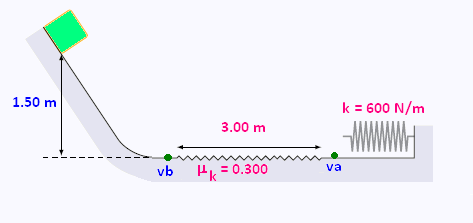
A 1.60 kg block starts from rest and slides along the surface shown below.
The surface is frictionless except for the rough patch indicated. After crossing
the rough patch the block hits a spring.
(a) What is the speed of the block just before it enters the rough patch ?
(b) What is the speed of the block after crossing the rough patch ?
(c) How far does the block compress the spring before it comes to rest ?
Answers:
(a)
(1/2) m vb2 - 0 = mg h
vb = √(2 g h)
vb = √(2 x 9.8 x 1.5) = 5.42 m/s
vb = 5.42 m/s
(b)
(1/2) m va2 - (1/2) m vb2 = μ m g x
vb2 = va2 - 2 μ g x
va2 = 5.42 2 - 2 (0.3) (9.8) (3) = 29.38 - 17.64
= 11.74
va = 3.43 m/s
va = 3.43 m/s
(c)
(1/2) m va2 = (1/2) k Δx2
m va2 = k Δx2
Δx2 = (m/k) va2
Δx = (m/k)1/2 va
Δx = (1.6/600)1/2 3.43 = 0.177 m
Δx = 0.17.7 cm
Problem 6
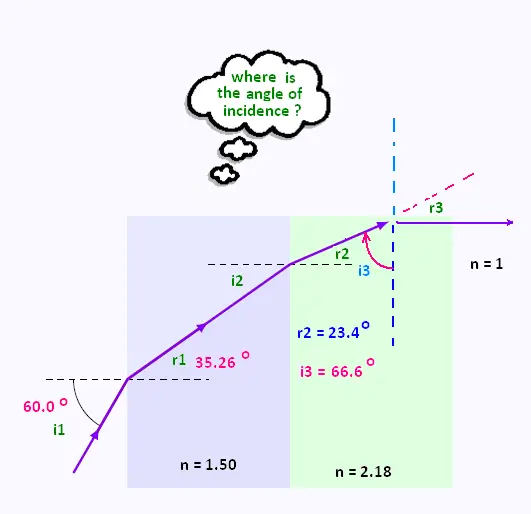
A stack of two transparent plates is surrounded by air. The indices of refraction of the plates are 1.50 and 2.18, respectively. Light in air is incident on the firrst plate at an angle of 60.0o relative to the normal.
(a) What is the angle of refraction when the light enters the second plate ?
(b) When the light reaches the top of the second plate will it pass through the boundary?
Justify your answer with a calculation.
Answers:
(a)
1 x sin 60 1.5 x sin r1 → r1 = 35.26o
r1 = i2
1.5 sin i2 = 2.18 sin r2 → r2 = 23.4o
r2 = 23.4o
(b)
r2 = i3
2.18 sin i3 = 1 x sin r3 = sin r3
sin r3 ≤ 1 → 2.18 sin i3 ≤ 1/2.18 = 0.4587
→ sin i3 ≤ 27.30o
But i3 = 66.6o larger than the critical angle θc = 27.30o
When the light reaches the top of the second plate, il will not pass through the boundary.
Problem 7
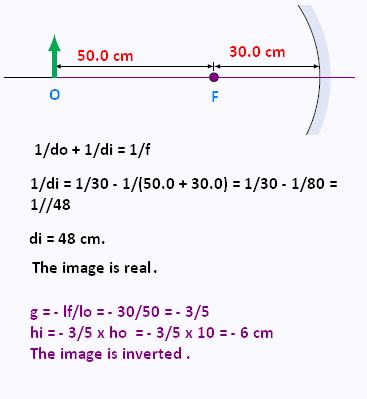
A 10.0 cm tall object is placed 80.0 cm in front of a concave mirror
with a focal length of 30.0 cm.
(a) What are the image distance and the image type (real or virtual) ?
(b) What are the image height and the orientation of the image (upright or inverted) ?
(c) Sketch a ray-diagram for this situation directly on the figure above. Indicate where the
image is formed.
(d) How will the image change as the object is slowly moved towards the mirror eventually
reaching its vertex? Briey explain.
Answers:
See the figure.
Part II: Multiple Choice Questions

Mirrors summary

|